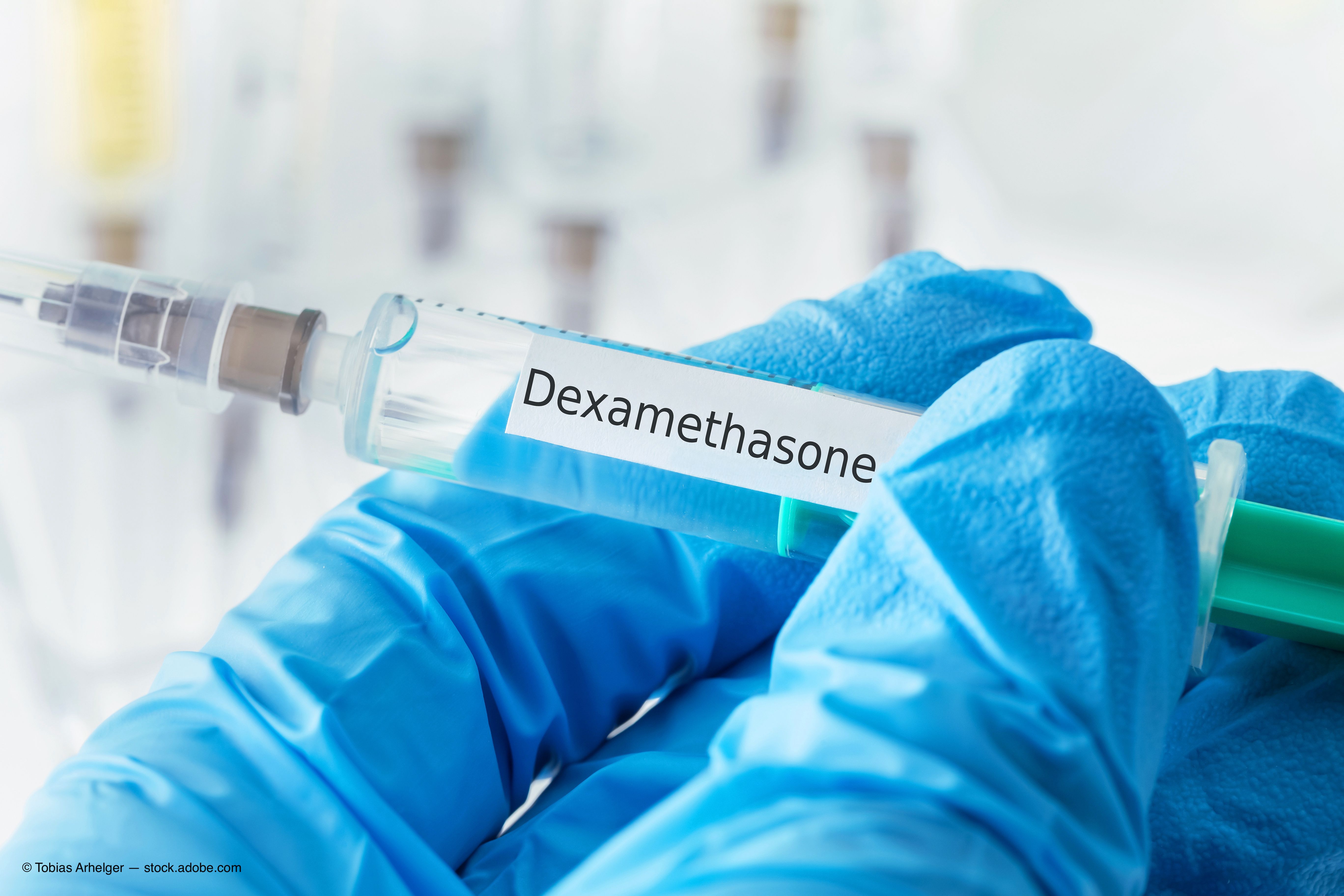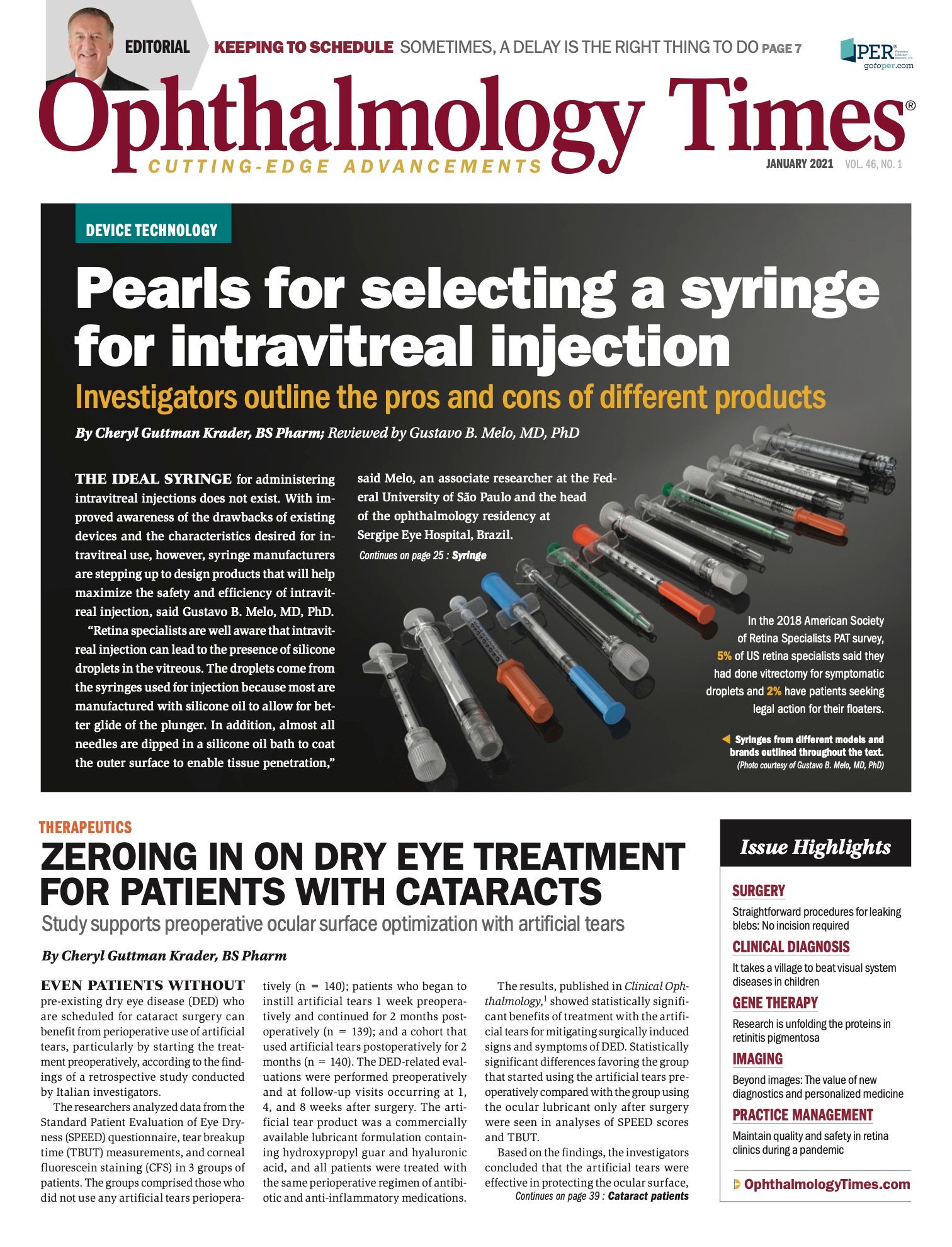Publication
Article
Digital Edition
Study: Innovative dexamethasone formulation shows efficacy, safety
Author(s):
Once-daily corticosteroid treats pain, inflammation after surgery.

This article was reviewed by Eric D Donnenfeld, MD
Results of a phase 2 trial suggest that OCS-01 (dexamethasone cyclodextrin nanoparticle ophthalmic suspension 1.5% mg/mL, Oculis), a novel topical formulation of dexamethasone, has the potential to become the first once-daily and preservative-free topical corticosteroid for treating pain and inflammation after ocular surgery, according to Eric D. Donnnenfeld, MD.
Donnenfeld reported results from the SKYGGN study, which randomly assigned 153 patients 1:1:1 to treatment with OCS-01 once daily, OCS-01 twice daily, or vehicle for 14 days.
Related: Dexamethasone intracameral drug-delivery suspension in vitreoretinal surgery inflammation
The study met its primary end points analyzing absence of anterior chamber cells at postoperative (postop) day 15 and absence of ocular pain at postop day 4. There were no efficacy differences between the two OCS-01 dosing regimens and both were safe and well tolerated.
“Inflammation and pain remain expected consequences of ocular surgery. Although available topical steroids are effective for treating these sequelae, potency and compliance with products that need to be used several times a day are major issues,” said SKYGGN investigator Donnenfeld, a clinical professor of ophthalmology at New York University Langone Medical Center, New York, and a founding partner at Ophthalmic Consultants of Connecticut.
“[With a] novel and proprietary nanoparticle formulation, OCS-01 was developed to deliver a potent anti-inflammatory effect and excellent safety profile with once-a-day dosing,” he said.
Related: Novel dexamethasone formulation shows efficacy and safety with once-daily use
Donnenfeld noted that the concentration of dexamethasone in OCS-01 is 15-fold greater than that found in commercially available topical dexamethasone suspension.
In addition, the novel vehicle used for OCS-01 increases ocular surface residency time to hours compared with the minutes using conventional dexamethasone 0.1% suspension.
Furthermore, the proprietary nanoparticle technology enhances penetration of the active ingredient. As another benefit, the formulation is preservative-free.
Related: Changing patient conversations around cataract surgery
SKYGGN design and outcomes
A total of 20 US centers participated in the SKYGGN study. Patients were eligible for enrollment if they had an anterior chamber cell score of 2 or greater at their first postop visit 18 to 30 hours post uncomplicated cataract surgery.
In addition, they had to have a pin-hole Early Treatment Diabetic Retinopathy Study (ETDRS) visual acuity without any other correction that was greater than 20 letters (approximately 20/400) in the operative eye and greater than 35 letters (approximately 20/200) in the fellow eye. Follow-up visits were scheduled at post-op days 4, 8, 15, and 22.
The 3 study groups were similar at baseline in their demographic characteristics, and 148 patients completed the study.
The mean age of patients across the 3 groups ranged from 66 to 68 years, approximately two-thirds of participants were female, and the majority were Caucasian.
Related: Dropless, hands-free regimen key for patients
The percentage of patients with absence of anterior chamber cells on day 15 in the OCS-01 once- daily, OCS-01 twice-daily, and vehicle group was 51.0%, 66.7%, and 45.1%, respectively (P < .0001 for both OCS-01 groups vs vehicle).
Absence of pain on day 4 was achieved by 72.5% of patients treated with OCS-01 once daily and by 19.6% of controls (P < .005). In the OCS-01 twice-daily group, 62.7% of patients were pain-free on day 4 (P = .074 vs vehicle).
“Data on [the] percentage of patients with absence of anterior chamber cells from earlier postoperative visits show [that] a statistically significant difference favoring the once-daily OCS-01 group versus vehicle was achieved on day 8,” Donnenfeld said. “The results for the pain assessment showed the proportion of patients who were pain-free increased in all groups as follow-up continued, but the difference was statistically significant between both OCS-01 groups and vehicle at days 8 and 15.”
Related: Antibiotic-steroid combination boosts confidence with delivery
One patient in the vehicle group and 1 patient treated with OCS-01 twice daily withdrew from the study because of an adverse event. However, there were no significant ocular or systemic adverse events.
Importantly, IOP of 30 mm Hg or greater was not observed in any patients at any follow-up visits nor did any patient have a 10 mm Hg or greater increase from baseline IOP.
“The overall adverse event rate was higher in the vehicle group than in the OCS-01 groups, probably because the adverse events were procedure related rather than treatment related,” Donnenfeld said.
Conclusion
Donnenfeld noted that the potent activity, safety, and tolerability of OCS-01 observed in SKYGGN are consistent with results of another phase 2 trial investigating the novel steroid formulation as a treatment for diabetic macular edema.
The latter study enrolled 144 patients and found a statistically significantly greater decrease in central macular thickness in patients treated with OCS-01 compared with vehicle-treated controls. There were no significant ocular adverse events in the OCS-01 group.
Read more by Cheryl Guttman Krader
--
Eric D. Donnenfeld, MD
e:ericdonnenfeld@gmail.com
Donnenfeld is a consultant to Oculis.

Newsletter
Don’t miss out—get Ophthalmology Times updates on the latest clinical advancements and expert interviews, straight to your inbox.




